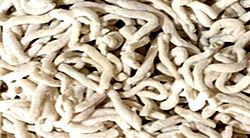Strozzapreti facts for kids

Uncooked Strozzapreti from Romagna
|
|
| Type | Pasta |
|---|---|
| Place of origin | Italy |
Strozzapreti is a special kind of pasta from Italy. It looks like an elongated cavatelli, which means it's hand-rolled. You can find it in regions like Emilia-Romagna, Tuscany, Marche, and Umbria. It's also popular in the country of San Marino.
Sometimes, the name Strozzapreti is also used for a baked dish. This dish is a dumpling made with cheese and vegetables. You can find this version in some parts of Italy and on the French island of Corsica.
Contents
Why is it called Strozzapreti?
The name "Strozzapreti" is quite interesting! It means "priest-choker" in Italian. There are many fun stories about how this pasta got its unusual name. Most of these stories come from a time when people in the region had mixed feelings about the local clergy.
One popular story says that priests loved this tasty pasta so much. They would eat it very quickly and sometimes even choke on it!
Another story involves the "azdora," which means "housewife" in the Romagna dialect. This story says that the housewife would "choke" the dough strips as she made the pasta. She might have been angry about the difficulties in her life. This anger could have been directed at the local priests, leading to a pasta that could "choke a priest."
A third story suggests that wives often made this pasta for churchmen. This was sometimes part of the payment for renting land from the church. Their husbands would get upset seeing the priests eat their wives' food. They would wish the priests would choke while stuffing their mouths with it. These stories show that people in Romagna and Tuscany sometimes had strong feelings about the clergy.
There's also a story that after Sunday church, priests would visit villagers' homes for dinner. If a priest really enjoyed the meal, he might come back too often. To politely tell the priest he was visiting too much, the family would serve this pasta. It later got the name "Strozzapreti." Another idea is that the pasta looks like a clerical collar, which is sometimes called a "Priest Choker."
What does Strozzapreti look like?
The name strozzapreti can refer to two different types of food. It can be a fresh pasta or a type of dumpling called gnocchi.
Pasta types
- In the Emilia-Romagna region, especially around Romagna, strozzapreti are short, twisted cords. They are made by hand from a simple dough of water and flour. In some areas, like between Faenza and Lugo, you might find strozzapreti col nodo. These have a little knot tied in each piece after twisting!
- In the cities of Imola and Ravenna, this pasta was once called "suffocated priests." This name is not used anymore. These pasta pieces were slightly larger than others.
- In the Emilia part of the region, the dough is different. It's made from flour, water, Parmesan cheese, and egg whites. All these ingredients are mixed together.
- In Umbria, strozzapreti or strangozzi means a long pasta. It has a square shape and is made only from water and flour.
- In the Latium region (around Rome), strozzapreti are like thick spaghetti. They are pulled by hand. In the area of Viterbo, a similar handmade pasta called stratto is common. It's often served with truffles.
- In the city of L'Aquila in Abruzzo, the strangolapreti are big, thick cords of pasta. They are made from durum wheat and are about 20 centimeters long.
- Pici is a similar pasta from Tuscany. It's also hand-rolled into solid, thick tubes of dough. However, unlike strozzapreti, pici are not twisted.
To make the pasta, the dough is rolled out into thick, flat sheets. Then, these sheets are cut into strips. The strips are gently rolled or twisted between the palms of the hands. Large pieces of pasta are then separated into about 10-centimeter lengths by pinching them. Unlike spaghetti, each piece of strozzapreti is unique in size and shape.
Gnocchi types
- In the Trentino and Milanese cuisine, strangolapreti are a type of gnocchi. They are made from stale bread, spinach, eggs, and grana cheese. They are usually served with melted butter and sage. In Milan and around Lake Como, soft cheese is also added to the mix.
- In Neapolitan cuisine, strangulapriévete refers to simple gnocchi. These are made at home with just water and flour.
- In Salento, strangulaprevati are potato dumplings.
- In Calabrian cuisine, strangugliapreviti are dumplings made from flour and eggs. In the nicastrese tradition, this dish is often eaten on Martedi' Grasso (Fat Tuesday).
- In Corsican cuisine, the name "sturzapréti" is used for large gnocchi. These are made with cheese and vegetables, then baked. Spinach or chard is seasoned and rolled into balls with brocciu cheese. These balls are baked in the oven. They are said to be large enough to choke a person if eaten whole!
See also
In Spanish: Strozzapreti para niños

